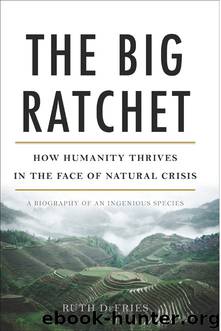The Big Ratchet: How Humanity Thrives in the Face of Natural Crisis by Ruth DeFries

Author:Ruth DeFries [DeFries, Ruth]
Format: epub, mobi
ISBN: 9780465080939
Publisher: Perseus Books, LLC
Scarecrows to Strychnine
Agriculture, and particularly stowaway species and genetically uniform monocultures, lock humanity into finding ways to overcome pests. Well before the pesticide bonanza of the past century, humans were adept at using their ingenuity to devise tricks to keep as much of the bounty for people and not pests. The ancient Egyptians had a clever strategy. During the season when the wheat was ripening, they hid in the rushes next to their fields. As the quail descended in hopes of a meal, the farmers jumped out, spread a net over the field, and made loud noises so the quail would attempt to fly away and get trapped in the net. Not just in Egypt, but all over the world, people tried to shoo crop-eating birds from their fields with noises, scarecrows, and decoys.
Scarecrows might ward off some birds, but they don’t scare away the weeds, insects, or harmful fungi and bacteria. People have weeded and picked off insect larvae by hand, selected disease-resistant plants to cultivate, and even used chemicals to manage these smaller pests since ancient times. Certainly by 900 CE, the Chinese were killing insects in their gardens with arsenic, and over the ensuing centuries people have found many ways to use chemicals to kill pests. Spraying nicotine-rich water extracted from tobacco is one; feeding poisonous seeds from strychnine trees to rodents is another; and spreading powder from natural toxins in pulverized chrysanthemum leaves is a third. In the mid-nineteenth century, commercially produced mixtures of sulfur, arsenic, lead, and other inorganic chemicals, which sold under colorful names such as Paris green, London purple, and Bordeaux mixture, came to the fore. People used these toxic mixtures to control mildew on grape vines in France and gypsy moths on apple trees in the eastern United States, until DDT appeared on the scene in the mid-twentieth century.
In much of the world, throughout history and into current times, commercial chemical pesticides have not been an option. Like the Peruvian shifting cultivator, many cannot afford pesticides, or have no way to access them even if they have the money. Traditional farmers deal with the threat by managing their fields with the reality of pests in mind. Cumulative experiences passed down through generations have provided ways to lessen the damage. With multiple crops planted in the same small field, traditional farmers do not risk the runaway damage that monocultures can entail. Consider a milpa farmer in the Guatemalan highlands who clears a small patch of jungle to make way for the three sister crops of Mesoamerica. A mix of corn, climbing beans, and different varieties of squash intermingle with other edible or medicinal plants, such as nightshade and tomatillo. The fields are not tidy, like one filled with neatly planted cornstalks, but if a harmful fungus were to take hold, it couldn’t run rampant like it did during the corn blight. The farmers let their hens in the field for a few days before planting, and the hens eat insects and turn the soil.
Download
The Big Ratchet: How Humanity Thrives in the Face of Natural Crisis by Ruth DeFries.mobi
This site does not store any files on its server. We only index and link to content provided by other sites. Please contact the content providers to delete copyright contents if any and email us, we'll remove relevant links or contents immediately.
The Leavers by Lisa Ko(6521)
Born to Run: by Christopher McDougall(6333)
iGen by Jean M. Twenge(4737)
Sapiens by Yuval Noah Harari(4635)
The Kite Runner by Khaled Hosseini(4538)
Spare by Prince Harry The Duke of Sussex(4270)
Bullshit Jobs by David Graeber(3243)
Livewired by David Eagleman(3184)
Goodbye Paradise(3028)
Never by Ken Follett(2973)
A Dictionary of Sociology by Unknown(2541)
Harry Potter 4 - Harry Potter and The Goblet of Fire by J.K.Rowling(2453)
The Club by A.L. Brooks(2427)
Machine Learning at Scale with H2O by Gregory Keys | David Whiting(2382)
People of the Earth: An Introduction to World Prehistory by Dr. Brian Fagan & Nadia Durrani(2371)
The Social Psychology of Inequality by Unknown(2353)
Harry Potter and the Deathly Hallows (7) by J.K. Rowling(2262)
0041152001443424520 .pdf by Unknown(2261)
Harry Potter and the Order of the Phoenix (5) by J.K. Rowling(2259)
